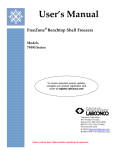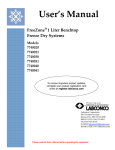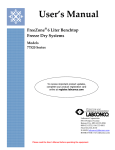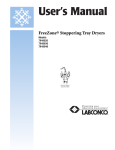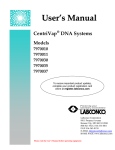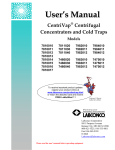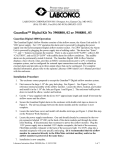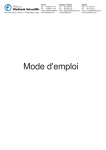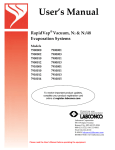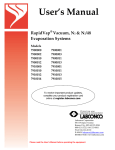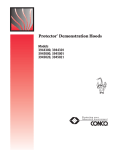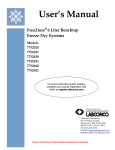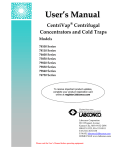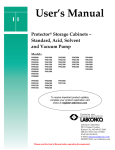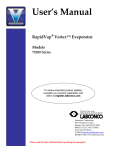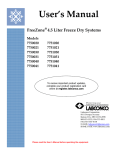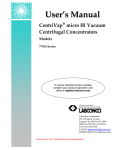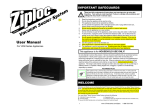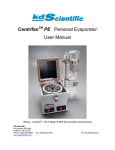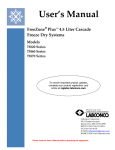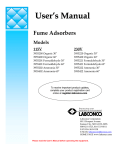Download User`s Manual - USF Research & Innovation
Transcript
User’s Manual FreeZone® Benchtop Shell Freezers Models 7949020 7949030 7949040 To receive important product updates, complete your product registration card online at register.labconco.com Labconco Corporation 8811 Prospect Avenue Kansas City, MO 64132-2696 800-821-5525, 816-333-8811 FAX 816-363-0130 E-MAIL [email protected] HOME PAGE www.labconco.com Please read the User’s Manual before operating the equipment. Copyright © 2004, 2007 Labconco Corporation. All rights reserved. The information contained in this manual and the accompanying products are copyrighted and all rights reserved by Labconco Corporation. Labconco Corporation reserves the right to make periodic design changes without obligation to notify any person or entity of such change. Warranty Labconco provides a warranty on all parts and factory workmanship. The warranty includes areas of defective material and workmanship, provided such defect results from normal and proper use of the equipment. The warranty for all Labconco products will expire one year from date of installation or two years from date of shipment from Labconco, whichever is sooner, except the following; • Purifier® Delta® Series Biological Safety Cabinets and PuriCare® Lab Animal Research Stations carry a three-year warranty from date of installation or four years from date of shipment from Labconco, whichever is sooner. • SteamScrubber® & FlaskScrubber® Glassware Washers carry a two-year warranty from date of installation or three years from date of shipment from Labconco, whichever is sooner. • Blood Drawing Chairs carry a ten year warranty. • Carts carry a lifetime warranty. • Glassware is not warranted from breakage when dropped or mishandled. This limited warranty covers parts and labor, but not transportation and insurance charges. In the event of a warranty claim, contact Labconco Corporation or the dealer who sold you the product. If the cause is determined to be a manufacturing fault, the dealer or Labconco Corporation will repair or replace all defective parts to restore the unit to operation. Under no circumstances shall Labconco Corporation be liable for indirect, consequential, or special damages of any kind. This statement may be altered by a specific published amendment. No individual has authorization to alter the provisions of this warranty policy or its amendments. Lamps and filters are not covered by this warranty. Damage due to corrosion or accidental breakage is not covered. Returned or Damaged Goods Do not return goods without the prior authorization from Labconco. Unauthorized returns will not be accepted. If your shipment was damaged in transit, you must file a claim directly with the freight carrier. Labconco Corporation and its dealers are not responsible for shipping damages. The United States Interstate Commerce Commission rules require that claims be filed with the delivery carrier within fifteen (15) days of delivery. Limitation of Liability The disposal and/or emission of substances used in connection with this equipment may be governed by various federal, state, or local regulations. All users of this equipment are required to become familiar with any regulations that apply in the user’s area concerning the dumping of waste materials in or upon water, land, or air and to comply with such regulations. Labconco Corporation is held harmless with respect to user’s compliance with such regulations. Contacting Labconco Corporation If you have questions that are not addressed in this manual, or if you need technical assistance, contact Labconco’s Customer Service Department or Labconco’s Product Service Department at 1-800-821-5525 or 1-816-333-8811, between the hours of 7:00 a.m. and 6:00 p.m., Central Standard Time. Part #7392209, Rev. A ECO E218 TABLE OF CONTENTS CHAPTER 1: INTRODUCTION Freeze Dry Process Freeze Dry Rates Freeze Dry Capacity Samples Containing Volatile Substances Sample Surface Area and Thickness of the Sample About This Manual Typographical Conventions 1 1 2 3 4 4 5 7 CHAPTER 2: PREREQUISITES Electrical Requirements Location Requirements 8 8 9 CHAPTER 3: GETTING STARTED Unpacking Your Benchtop Shell Freezer Benchtop Shell Freezer Components Installing Your Benchtop Shell Freezer Electrical Connection Solvent Safety Precautions 10 10 11 12 12 12 CHAPTER 4: USING YOUR BENCHTOP SHELL FREEZER Benchtop Shell Freezer Controls Operating the Benchtop Shell Freezer 14 15 15 CHAPTER 5: MAINTAINING YOUR BENCHTOP SHELL FREEZER 17 APPENDIX A: BENCHTOP SHELL FREEZER COMPONENTS 19 APPENDIX B: BENCHTOP SHELL FREEZER DIMENSIONS 21 APPENDIX C: BENCHTOP SHELL FREEZER SPECIFICATIONS Electrical Specifications Environmental Conditions Wiring Diagram (115V) Wiring Diagram (230V) 22 22 22 24 25 DECLARATION OF CONFORMITY 26 CHAPTER 1 INTRODUCTION Congratulations on your purchase of a Labconco FreeZone® Benchtop Shell Freezer, which is designed to prepare samples for laboratory lyophilization procedures. The unit is easy to install and maintain. Proper care and maintenance of this product will result in many years of dependable service. Freeze Dry Process Freeze drying is an important process in sample preparation and for the preservation and storage of biologicals, pharmaceuticals and foods. Of the various methods of dehydration, freeze drying (lyophilization) is especially suited for substances that are heat sensitive. Other than food processing (e.g., coffee, whole dinners), freeze drying has been extensively used in the development of pharmaceuticals (e.g., antibiotics) and preservation of biologicals (e.g., proteins, plasma, viruses and cell lines). The nondestructive nature of this process has been demonstrated by the retention of viability in freeze dried viruses and microorganisms. Freeze drying is a process whereby water or other solvent is removed from frozen material by converting the frozen water directly into vapor without the intermediate formation of liquid water. The basis for this sublimation process involves the absorption of heat by the frozen sample in order to vaporize the ice; the use of a vacuum pump to enhance the removal of water vapor from the surface of the sample; the transfer of water vapor to a collector; and the removal of heat by the collector in order to condense the water vapor. In essence, the freeze dry process is a balance between the heat absorbed by the sample to vaporize the ice and the heat removed from the collector to convert the water vapor into ice. Product Service: Domestic 1-800-522-7658, International 816-333-8811 1 Chapter 1: Introduction Freeze Dry Rates The efficiency of the freeze drying process is dependent upon the surface area and the thickness of the sample, the collector temperature and vacuum obtained, the eutectic point and solute concentration of the sample. It is important to remember these factors when trying to obtain efficient utilization of your freeze dry system. A listing of selected materials and their approximate drying times are shown in Table 1 for your reference. Table 1 SAFE TEMPERATURE AND DRYING TIMES FOR SELECTED MATERIALS Material Safe Collector Hours 10mm Thick Temperature Temperature (Approx.) °C °C Milk -5 -40 10 Urea -7 -40 10 Blood Plasma -10 to -25 -40 16 Serum -25 -40 18 Vaccinia -30 to -40 -50 22 Influenza Vaccine -30 -50 24 Human Tissue -30 to -40 -50 48 Vegetable Tissue -50 -80 60 *Total sample quantities are contingent on various freeze dryer capacities. Up to the point of overloading the system, the greater the surface area of the sample, the faster the rate of freeze drying. By contrast, for a given surface area, the thicker the sample the slower the rate of freeze drying. This is based on the fact that the heat of sublimation is usually absorbed on one side of the frozen sample and must travel through the frozen layer to vaporize water at the other surface. In addition, as the sample is freeze dried, the water vapor must travel through the layer of dried material. The thicker the sample, the greater the chance that the dried layer may collapse which would cause an additional decrease in the rate of freeze drying. The surface area and thickness of the sample can usually be ignored when each sample contains only a few milliliters. However, for larger volumes, the samples should be shell frozen to maximize the surface area and minimize the thickness of the sample. The volume of the freeze dry flask should be two to three times the volume of the sample. 2 Product Service: Domestic 1-800-522-7658, International 816-333-8811 Chapter 1: Introduction In order for lyophilization to occur, ice must be removed from the frozen sample via sublimation. This is accomplished by the collector and the vacuum pump. The collector, which should be at least 15 to 20°C colder than the eutectic temperature (melting temperature) of the sample, traps vapor as ice. Since the vapor pressure at the collector is lower than that of the sample, the flow of water vapor is from the sample to the collector. Since this vapor diffusion process occurs very slowly under normal atmospheric conditions, a good vacuum is essential to maintain an efficient rate. In many applications, the maintenance of a vacuum of 0.133 mBar or less is recommended. The rate of freeze drying is directly proportional to the vapor pressure and the vapor pressure is dependent upon both eutectic temperature and solute concentration of the sample. For example, a solution of sodium chloride and water would freeze dry at a slower rate than pure water. The eutectic temperature of a sodium chloride solution is about –21°C and at this temperature the vapor pressure is about 1/16 that of water at 0°C. Although the eutectic temperature is not dependent upon the concentration of sodium chloride, the vapor pressure of the water would decrease as the concentration of sodium chloride increased. This is due to the fact that as the solute concentration increases, less of the surface area of the frozen sample is occupied by water. In general, most solutions or biological samples will have a eutectic temperature of –10° to –25°C. However, if the sample contains a simple sugar such as glucose or if the sample is animal or plant tissue, the eutectic temperature may be as low as –30° to –50°C. Freeze Dry Capacity The volume of a sample that can be freeze dried at one time is related to factors discussed previously and the size and design of the freeze dry system. With any given instrument, the capacity is based on the surface area of the sample, the eutectic temperature and concentration of the sample and the rate and amount of heat transferred to the frozen sample. Of these factors, the eutectic temperature is the most important factor in determining the amount of sample that can be freeze dried at one time, particularly when flasks are used. This is because as the eutectic temperature decreases, the vapor pressure decreases but the rate of heat absorption by the sample does not change. This tends to promote melting of the sample, which leads to a marked increase in vapor pressure and ultimately overloads the collector and vacuum pump. Samples that have eutectic temperatures of –20°C or lower should be placed on the freeze dry system one flask at a time so that the Product Service: Domestic 1-800-522-7658, International 816-333-8811 3 Chapter 1: Introduction vacuum in the system may recover before adding another sample to the system. If the vacuum does not recover, the capacity of the freeze dry system has been exceeded and the sample should be removed. If there is a problem with a particular type of sample melting when placed on the freeze dry system, dilution of the sample with more water or providing some insulation around the flask to decrease the rate of heat absorption by the sample may help. If the eutectic temperature of the sample is –40 to –60°C, the freeze dry system selected for use must be equipped with cascade type refrigeration so that the collector temperature can be cooled to below –75°C, or a dry ice/solvent trap may be used between the collector and the vacuum pump. Samples Containing Volatile Substances In certain cases the solvent in a sample to be freeze dried may contain volatile components such as acetonitrile, methanol, acetic acid, formic acid or pyridine. In addition to these substances having an effect on the eutectic temperature, they may increase the vapor pressure at the surface of the sample. Also, compared to water, they will require the absorption of less heat for sublimation to occur. Hence, samples that contain volatile substances will have a greater tendency to melt, particularly when placed in flasks or exposed to room temperature. If a sample containing a volatile substance tends to melt when placed on a freeze dry system, dilution of the sample with more water will help keep the sample frozen. For example, a 0.2M solution of acetic acid is much easier to freeze dry than a 0.5M solution. Sample Surface Area and Thickness of the Sample The volume and configuration of the suspension to be freeze dried often determines how the material will be freeze dried. For example, the greater the ratio of the surface area to the volume of the suspension, the faster drying will occur. This is because a greater area for the water molecules to leave the product exists compared to the distance they have to travel to reach the surface of the frozen matrix. Drying occurs from the top of the product and initially the removal of water molecules is efficient. However, as the drying front moves down through the product, drying becomes more and more difficult. The water molecules must now travel 4 Product Service: Domestic 1-800-522-7658, International 816-333-8811 Chapter 1: Introduction through the dried portions of the product, which impedes their progress. As the drying front moves further and further down the matrix, the application of heat to the product becomes more important. Shell freezing as a method of prefreezing the product can increase the surface area-to-volume ratio by spreading out the frozen product inside the vessel. Shell freezing is accomplished by rotating the vessel in a low temperature bath causing the product to freeze in a thin layer on the inside surface of the vessel. The thickness of the frozen suspension depends on the volume of the product in comparison to the size of the vessel. The diagram below shows how a Shell Freezer operates. About This Manual This manual is designed to help you learn how to install, use, and maintain your Benchtop Shell Freezer. Instructions for performing routine maintenance and making minor modifications to your Benchtop Shell Freezer are also included. Chapter 1: Introduction provides a brief overview of the freeze dry process, explains the organization of the manual, and defines the typographical conventions used in the manual. Chapter 2: Prerequisites explains what you need to do to prepare your site before you install your Benchtop Shell Freezer. Electrical requirements are discussed. Product Service: Domestic 1-800-522-7658, International 816-333-8811 5 Chapter 1: Introduction Chapter 3: Getting Started contains the information you need to properly unpack, inspect and install your Benchtop Shell Freezer. Chapter 4: Using Your Benchtop Shell Freezer discusses the basic operation and information on how to load samples. Chapter 5: Maintaining Your Benchtop Shell Freezer explains how to perform routine maintenance. Chapter 6: Troubleshooting contains information about problems you may encounter while using your Benchtop Shell Freezer, including the probable causes of the problems, and suggested corrective actions. Appendix A: Benchtop Shell Freezer Components contains labeled diagrams of the key components of the Benchtop Shell Freezer. Appendix B: Benchtop Shell Freezer Dimensions contains diagrams showing the dimensions for the Benchtop Shell Freezer. Appendix C: Benchtop Shell Freezer Specifications contains product specifications and wiring diagrams. 6 Product Service: Domestic 1-800-522-7658, International 816-333-8811 Chapter 1: Introduction Typographical Conventions Recognizing the following typographical conventions will help you understand and use this manual: • • • ! ) • • Book, chapter, and section titles are shown in italic type (e.g., Chapter 3: Getting Started). Steps required to perform a task are presented in a numbered format. Comments located in the margins provide suggestions, reminders, and references. Critical information is presented in boldface type in paragraphs that are preceded by the exclamation icon. Failure to comply with the information following an exclamation icon may result in injury to the user or permanent damage to your Shell Freezer. Important information is presented in capitalized type in paragraphs that are preceded by the pointer icon. It is imperative that the information contained in these paragraphs be thoroughly read and understood by the user. Product Service: Domestic 1-800-522-7658, International 816-333-8811 7 CHAPTER 2 PREREQUISITES Before you install your Benchtop Shell Freezer, you need to prepare your site for installation. The Benchtop Shell Freezer may be mounted on top of a benchtop work surface. Carefully examine the location where you intend to install your Benchtop Shell Freezer. You must be certain that the area is level and of solid construction. An electrical source must be located near the installation site. Carefully read this chapter to learn: • • the electrical supply requirements. location requirements. Refer to Appendix C: Benchtop Shell Freezer Specifications for complete Benchtop Shell Freezer electrical and environmental conditions, specifications and requirements. Electrical Requirements The Benchtop Shell Freezer requires a dedicated electrical outlet. This outlet requires a 15 Amp circuit breaker or fuse for models rated at 115V (60 Hz). An outlet equipped with a 8 Amp circuit breaker or fuse is required for models rated at 230V (50/60 Hz). The power cord on 115V models is equipped with a 15 Amp NEMA 5-15P plug. The power cord on 230V models is equipped with a NEMA 6-15P plug. If this does not match with the available receptacle, remove this plug and replace it with an approved plug of the suitable style. 8 Product Service: Domestic 1-800-522-7658, International 816-333-8811 Chapter 2: Prerequisites Location Requirements The Benchtop Shell Freezer should be located in an area that provides an unobstructed flow of air around the cabinet. This air cools the refrigeration system. A minimum of 3" must be allowed between the back and both sides of the Benchtop Shell Freezer and adjacent wall surfaces. Restriction of airflow during operation could adversely affect performance. Refer to Appendix B: Benchtop Shell Freezer Dimensions for dimensional drawings of the Benchtop Shell Freezer. Product Service: Domestic 1-800-522-7658, International 816-333-8811 9 CHAPTER 3 GETTING STARTED Now that the site for your Benchtop Shell Freezer is properly prepared, you are ready to unpack, inspect, install and test your Benchtop Shell Freezer. Read this chapter to learn how to: • • • • ! unpack and move your Benchtop Shell Freezer. set up your Benchtop Shell Freezer. connect the electrical supply source to your Benchtop Shell Freezer. safely use solvents with your Benchtop Shell Freezer. The Benchtop Shell Freezer weighs over 90 lbs. (41 Kg). The carton allows for lifting with a mechanical lift truck or hand truck. If you must lift the Benchtop Shell Freezer manually, use at least two (2) persons and follow safe lifting guidelines. Unpacking Your Benchtop Shell Freezer The United States Interstate Commerce Commission rules require that claims be filed with the delivery carrier within fifteen (15) days of delivery. 10 Carefully unpack your Benchtop Shell Freezer and inspect it for damage that may have occurred in transit. If your Benchtop Shell Freezer is damaged, notify the delivery carrier immediately and retain the entire shipment intact for inspection by the carrier. Product Service: Domestic 1-800-522-7658, International 816-333-8811 Chapter 3: Getting Started ) DO NOT RETURN GOODS WITHOUT THE PRIOR AUTHORIZATION OF LABCONCO. UNAUTHORIZED RETURNS WILL NOT BE ACCEPTED. ) IF YOUR BENCHTOP SHELL FREEZER WAS DAMAGED IN TRANSIT, YOU MUST FILE A CLAIM DIRECTLY WITH THE FREIGHT CARRIER. LABCONCO CORPORATION AND ITS DEALERS ARE NOT RESPONSIBLE FOR SHIPPING DAMAGE. ) DO NOT DISCARD THE CARTON OR PACKING MATERIALS UNTIL YOU HAVE CHECKED ALL OF THE COMPONENTS AND INSTALLED AND TESTED THE BENCHTOP SHELL FREEZER. Benchtop Shell Freezer Components Locate the model of Benchtop Shell Freezer you received in the following table. Verify that the components listed are present and undamaged. Catalog # Product Description 7949020 7949030 7949040 Benchtop Shell Freezer - 115V, 60 Hz Benchtop Shell Freezer - 230V, 50 Hz Benchtop Shell Freezer - 230V, 60 Hz Plus the following: Part # Qty. 7392209 1334500 1 1 1338000 1 Component Description User’s Manual Power Cord – 115V Or Power Cord – 230V If you did not receive one or more of the components listed for your Benchtop Shell Freezer, or if any of the components are damaged, contact Labconco Corporation immediately for further instructions. Product Service: Domestic 1-800-522-7658, International 816-333-8811 11 Chapter 3: Getting Started Installing Your Benchtop Shell Freezer After you verify receipt of the proper components, move your Benchtop Shell Freezer to the location where you want to install it. Then, follow the steps listed below. 1. Check that the solvent bath drain plug is securely installed in the drain hose. 2. Remove bath compartment cover and add solvent to bath compartment. Commonly used solvents are methanol or ethanol. Recommended solvent depth is 1/4" to 1/2" above the top of the rollers (approximately 2 liters). ! If flammable solvents are used in the shell freezer bath, be sure to keep away from open flame. Electrical Connection Plug the power cord into the receptacle on the back of the Benchtop Shell Freezer and plug the other end into a suitable power receptacle. ) ! DO NOT ATTEMPT TO PLUG THE BENCHTOP SHELL FREEZER INTO A FREEZONE FREEZE DRY SYSTEM. Solvent Safety Precautions Solvents used in the Benchtop Shell Freezer may be flammable or hazardous to your health. Use extreme caution and keep sources of ignition away from the solvents. Hazardous materials such as strong acids or bases, radioactive substances and volatile organics must be handled carefully and promptly cleaned up if spilled. If a sample is spilled, it must immediately be cleaned up. 12 Product Service: Domestic 1-800-522-7658, International 816-333-8811 Chapter 3: Getting Started WARNING: The disposal of substances used in connection with this equipment may be governed by various Federal, State or local regulations. All users of this equipment are urged to become familiar with any regulations that apply in the user’s area concerning the dumping of waste materials in or upon water, land or air and to comply with such regulations. Product Service: Domestic 1-800-522-7658, International 816-333-8811 13 CHAPTER 4 USING YOUR BENCHTOP SHELL FREEZER After your Benchtop Shell Freezer has been installed as detailed in Chapter 3: Getting Started, you are ready to begin using your Benchtop Shell Freezer. Read this chapter to learn how to: • • • operate the controls. understand the display. load samples. ! 14 Do not use the Benchtop Shell Freezer in a manner not specified by the manufacturer (refer to Appendix C: Benchtop Shell Freezer Specifications). The electrical protection properties of the Benchtop Shell Freezer may be impaired if the Benchtop Shell Freezer is used inappropriately. Product Service: Domestic 1-800-522-7658, International 816-333-8811 Chapter 4: Using Your Benchtop Shell Freezer Benchtop Shell Freezer Controls The control panel for the Benchtop Shell Freezer is shown below with a description about its function. 1. Main Power Switch- (Not shown - Located on right side of cabinet) turns the unit on or off. 2. Bath Temperature Graph Display – This display indicates the temperature of the solvent in the Benchtop Shell Freezer bath. The top LED turns on when the main power switch is turned on. The second LED turns on when the bath temperature reaches approximately –20°C. The third LED turns on when the bath temperature reaches approximately –30°C. The fourth LED turns on at approximately –35°C. The fifth LED turns on at approximately –38°C. The sixth LED turns on at approximately –40°C. The bottom LED turns on at approximately –42°C. Operating the Benchtop Shell Freezer The Benchtop Shell Freezer is designed for shell freezing samples in flasks in preparation for freeze drying. It can process the following Labconco flasks Quantity 1 1 1 1 1 2 2 2 2 Flask Size 1200 ml Flask 900 ml Flask 750 ml Flask 600 ml Flask 300 ml Flask 150 ml Flask 120 ml Flask 80 ml Flask 40 ml Flask Product Service: Domestic 1-800-522-7658, International 816-333-8811 15 Chapter 4: Using Your Benchtop Shell Freezer Follow the steps below each time you use the shell freezer to obtain optimum performance: 1. Check that the solvent bath drain plug is securely installed in the drain hose. 2. Remove the bath compartment cover and add solvent to the bath compartment. Commonly used solvents are methanol or ethanol. Recommended solvent depth is 1/4" to 1/2" above the top of the rollers (approximately 2 liters). ! ! 16 If flammable solvents are used in the shell freezer bath, be sure to keep away from open flame. 3. Press the main power switch. The top LED will illuminate. The shell freezer refrigeration module will start and the bath rollers will begin rotating. 4. Fill a freeze dry container no more than ½ full with sample and stopper the container top. Lay the container on the rollers in a horizontal position. Replace the bath compartment cover during shell freezing. 5. When the sample is completely frozen in the container, remove the container from the bath compartment and freeze dry the sample or place it in a suitable storage freezer for future freeze drying. 6. Press the main power switch to turn shell freezer off. 7. If the Benchtop Shell Freezer is to be used for cold bath operation, additional solvent may be added to submerge small flasks. Do not fill pan more than 2 inches below the top of the stainless steel pan with vessels submerged. Allow additional time for larger volumes of solvent to reach lower temperatures. 8. Always drain flammable solvents from the bath when the shell freezer is not in use and store the solvent in a suitable container. This is accomplished by first pulling the drain hose out of the left side panel of the unit and then removing the drain plug. Place the hose in a suitable container to collect the solvent. Product Service: Domestic 1-800-522-7658, International 816-333-8811 CHAPTER 5 MAINTAINING YOUR BENCHTOP SHELL FREEZER Under normal operation, the Benchtop Shell Freezer requires little maintenance. The following maintenance schedule is recommended: As needed: 1. If the heat transfer liquid in the bath becomes contaminated, drain and replace. It is the user’s responsibility to dispose of it in accordance with all applicable regulations. 2. Clean up all spills. 3. Clean the lid and gasket using a soft cloth, sponge or chamois and a mild, non-abrasive soap or detergent. Monthly: 1. Check the drain hose and lid gasket and replace if they show signs of hardening, permanent set or deterioration. 2. Using a soft cloth, sponge or chamois and a mild, non-abrasive soap or detergent, clean the bath lid. 3. Using a soft cloth, sponge, or chamois and a mild, non-abrasive soap or detergent, clean the exterior surfaces of the unit. Liquid spray cleaners and polishes may be used on the exterior Product Service Domestic 1-800-522-7658, International 816-333-8811 17 Chapter 5: Maintaining Your Benchtop Shell Freezer surfaces. Do not use solvents to remove stains from the exterior surfaces as they may damage the finish. Annually: 1. Every 12 months, or more often if the Benchtop Shell Freezer is operated in a dusty environment, the refrigeration system condenser should be cleaned. Using a vacuum cleaner and brush attachment, clean the condenser to ensure proper airflow for peak performance. It can be accessed by removing the front lower panel. 18 Product Service: Domestic 1-800-522-7658, International 816-333-8811 APPENDIX A BENCHTOP SHELL FREEZER COMPONENTS The following pages list components that are available for your Benchtop Shell Freezer. The parts shown are the most common replacement parts. If other parts are required, contact Product Service. Product Service Domestic 1-800-522-7658, International 816-333-8811 19 Appendix A: Benchtop Shell Freezer Components Item Qty Part No. Description 1 2 3 4 5 6 7 8 1 1 1 1 1 1 1 1 9 1 7403100 7408400 1305200 7394400 7392208 7624100 7728000 7519100 7519101 7515300 Lid Gasket – Lid Switch Printed Circuit Board Label Hose – Drain Plug – Drain Drive Motor 115V Drive Motor 230V Temperature Sensor 1 9 8 2 4 7 5 5 6 3 20 Product Service: Domestic 1-800-522-7658, International 816-333-8811 APPENDIX B BENCHTOP SHELL FREEZER DIMENSIONS Product Service Domestic 1-800-522-7658, International 816-333-8811 21 APPENDIX C BENCHTOP SHELL FREEZER ELECTRICAL SPECIFICATIONS This Appendix contains technical information about the Freeze Dryer including electrical specifications, environmental operating conditions and wiring diagrams. Electrical Specifications Catalog Operating Number Nominal Range Frequency Phase Amperage 7949020 115 103-127 60 1 6 100 90-110 50 1 6 7949030 230 198-254 50 1 2.5 7949040 230 187-253 60 1 2.5 Environmental Conditions • Indoor use only. • Maximum altitude: 6562 feet (2000 meters). • Ambient temperature range: 41° to 104°F (5° to 40°C). • Maximum relative humidity: 80% for temperatures up to 88°F (31°C), decreasing linearly to 50% relative humidity at 104°F (40°C). • Main supply voltage fluctuations not to exceed ±10% of the nominal voltage. • Transient over voltages according to Installation Categories II (Over voltage Categories per IEC 1010). Temporary voltage spikes on the AC input line that may be as high as 1500V for 115V models and 2500V for 230V models are allowed. • Used in an environment of Pollution degrees 2 (i.e., where normally only non-conductive atmospheres are present). 22 Product Service Domestic 1-800-522-7658, International 816-333-8811 Appendix C: Benchtop Shell Freezer Specifications Occasionally, however, a temporary conductivity caused by condensation must be expected, in accordance with IEC 664. Product Service: Domestic 1-800-522-7658, International 816-333-8811 23 Appendix C: Benchtop Shell Freezer Specifications Wiring Diagram (115V, 60 Hz Model) 24 Product Service: Domestic 1-800-522-7658, International 816-333-8811 Appendix C: Benchtop Shell Freezer Specifications Wiring Diagram (230V, 60 or 50 Hz Models) Product Service: Domestic 1-800-522-7658, International 816-333-8811 25 DECLARATION OF CONFORMITY Application Council Directive(s): 73/23/EEC, 89/336/EEC Standard(s) to which conformity is declared: EN61010, EN55022, EN50082-1 Manufacturer’s Name: Labconco Corporation Manufacturer’s Address: 8811 Prospect Avenue Kansas City, MO 64132 USA Importer’s Name: See Shipping/Customs Documents* Importer’s Address: See Shipping/Customs Documents for your equipment Type of Equipment: Laboratory Equipment – Benchtop Shell Freezer Model No.: 7949030 Serial No.: Various – See Individual Declaration Year of Manufacture: 2004 and Subsequent I, the undersigned, hereby declare that the equipment specified above conforms to the above Directive(s) and Standard(s). See individual Declaration of Conformity which will be signed by the importer for your country. Place: _______________________________________ (Signature) Date: _______________________________________ (Full Name) _______________________________________ (Position) *An individual version of this declaration is included with your shipping/customs documentation. Labconco P/N 36960-40, Rev. A, ECO C729 26 Product Service Domestic 1-800-522-7658, International 816-333-8811





























